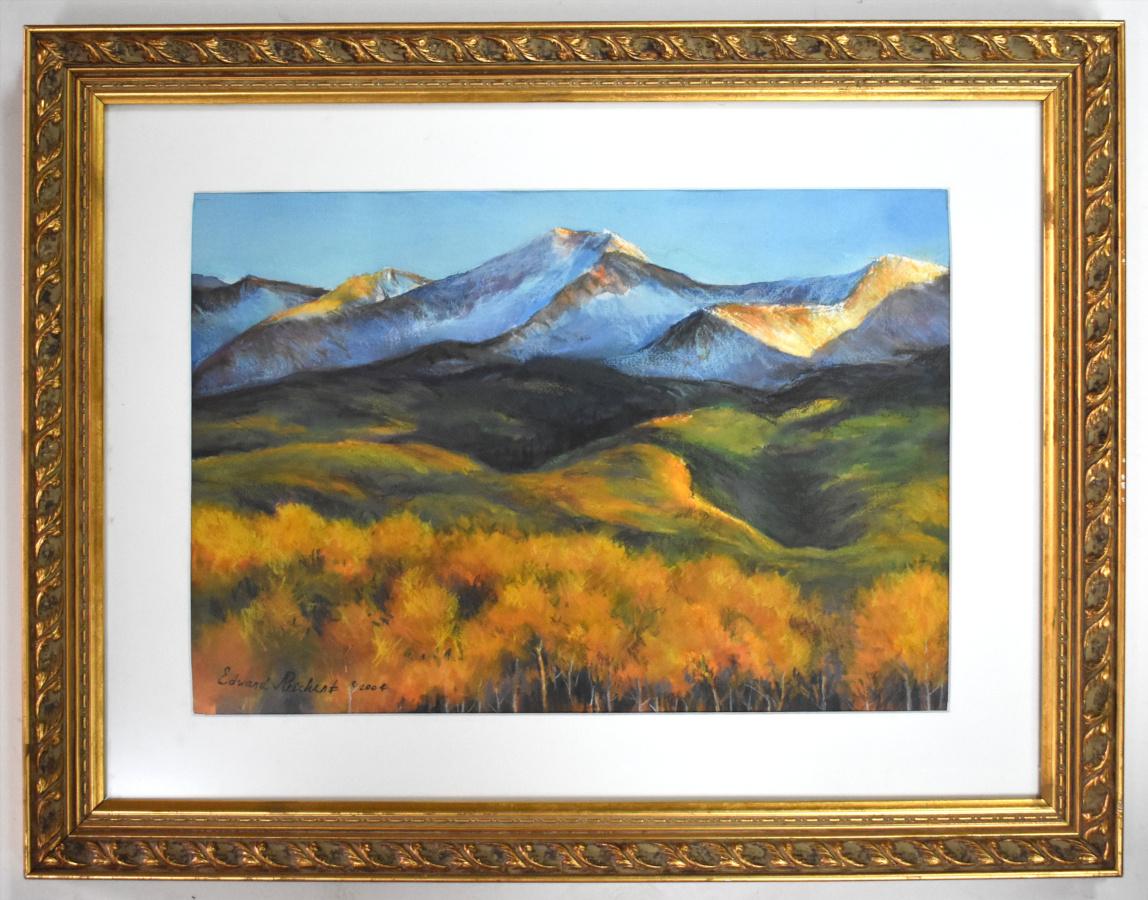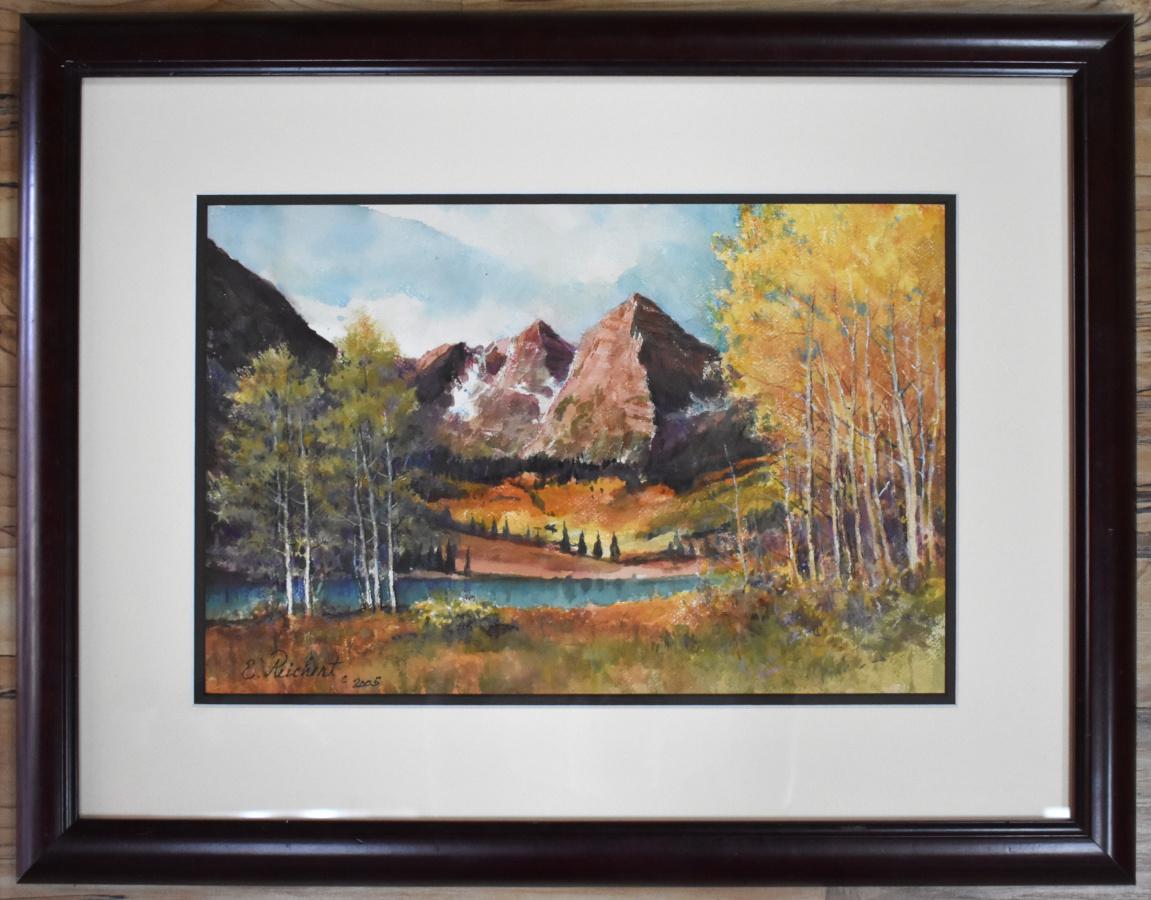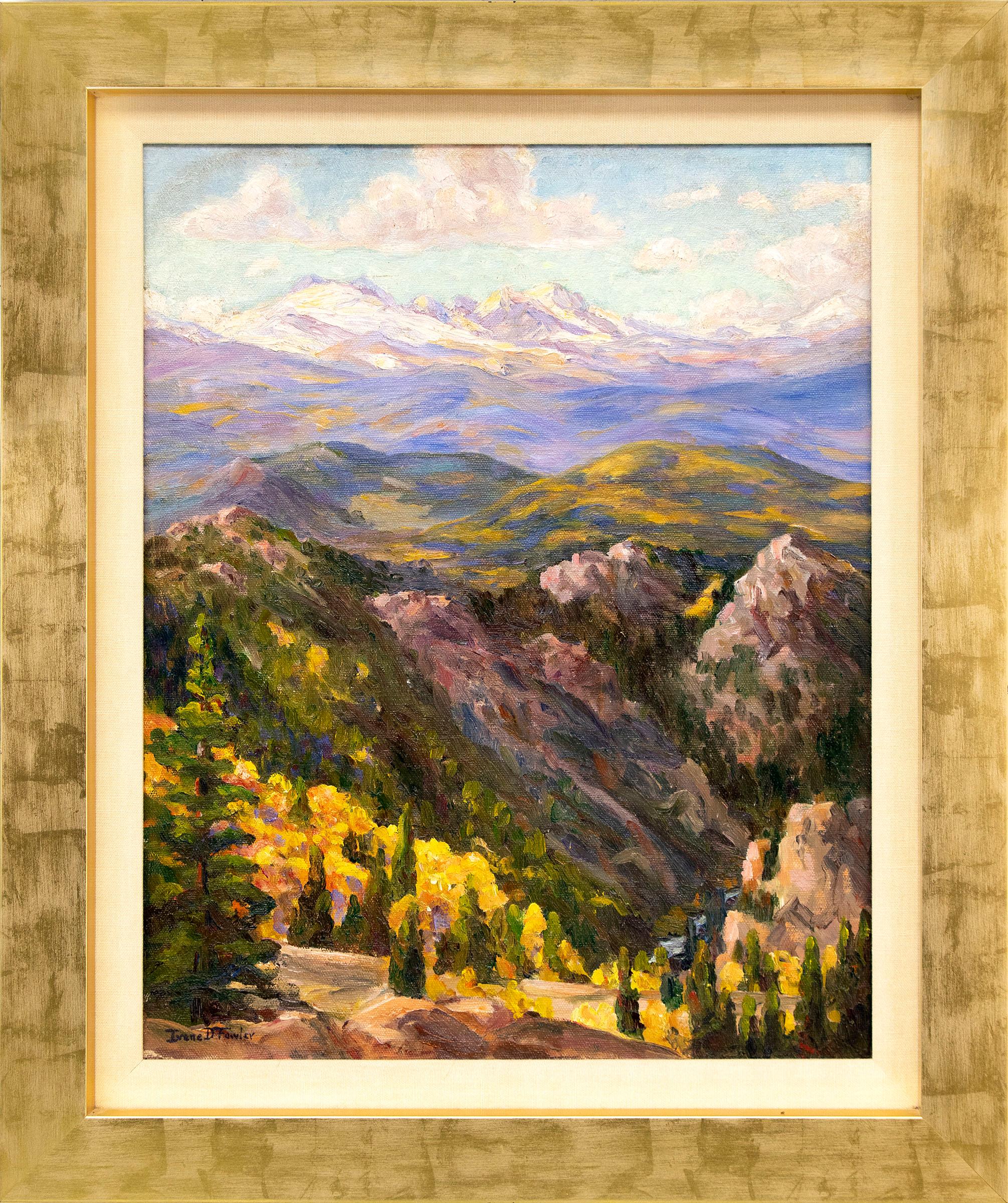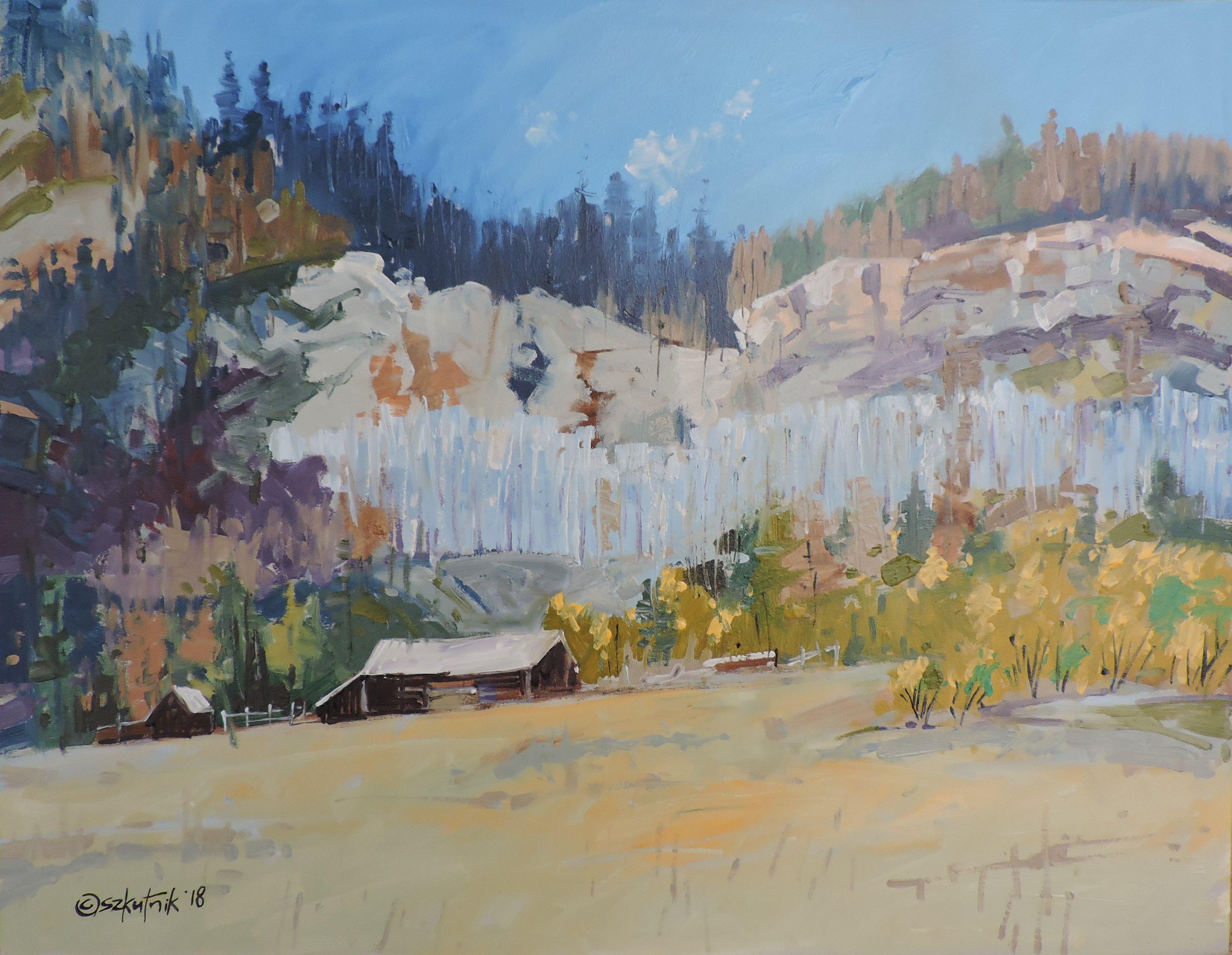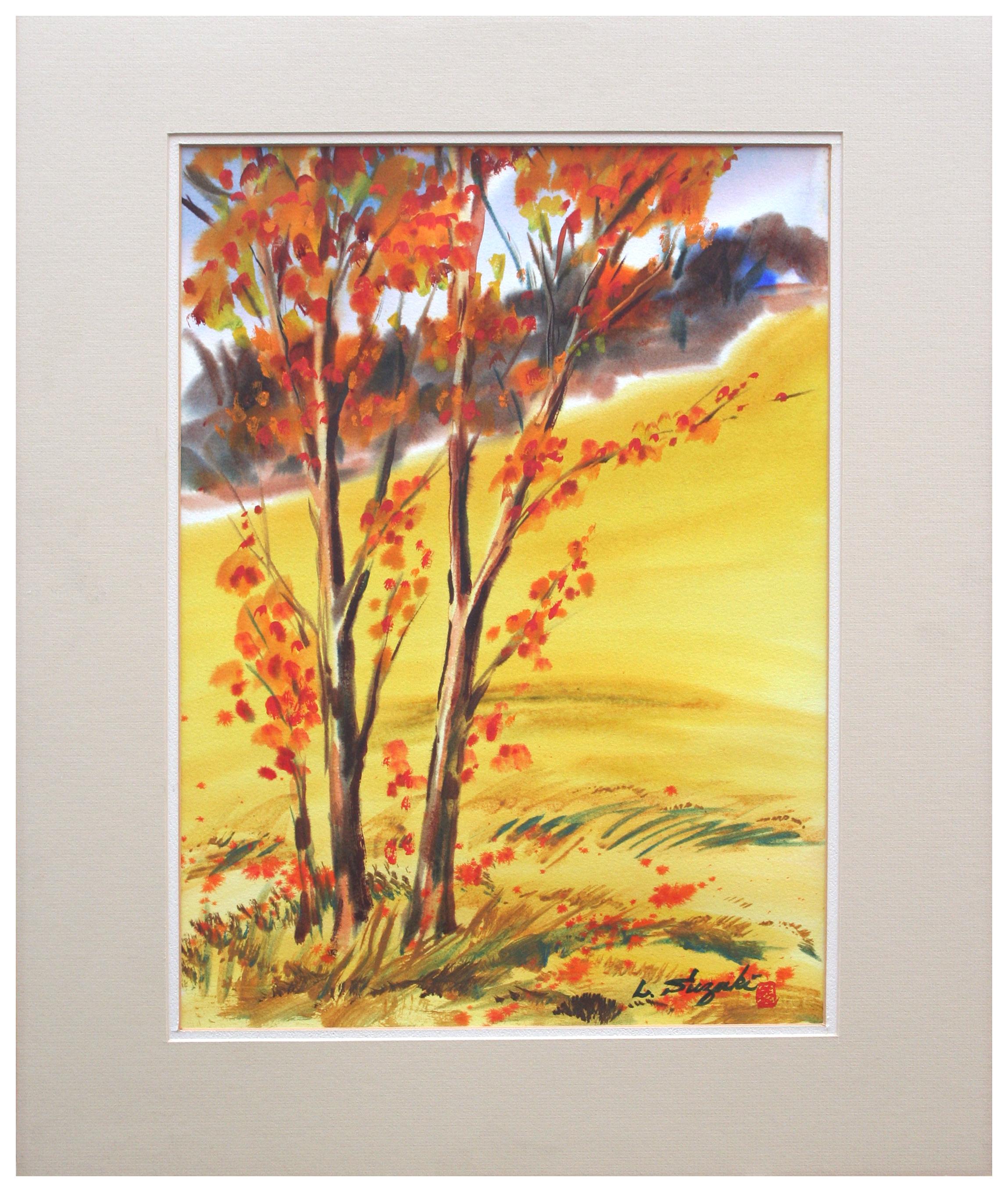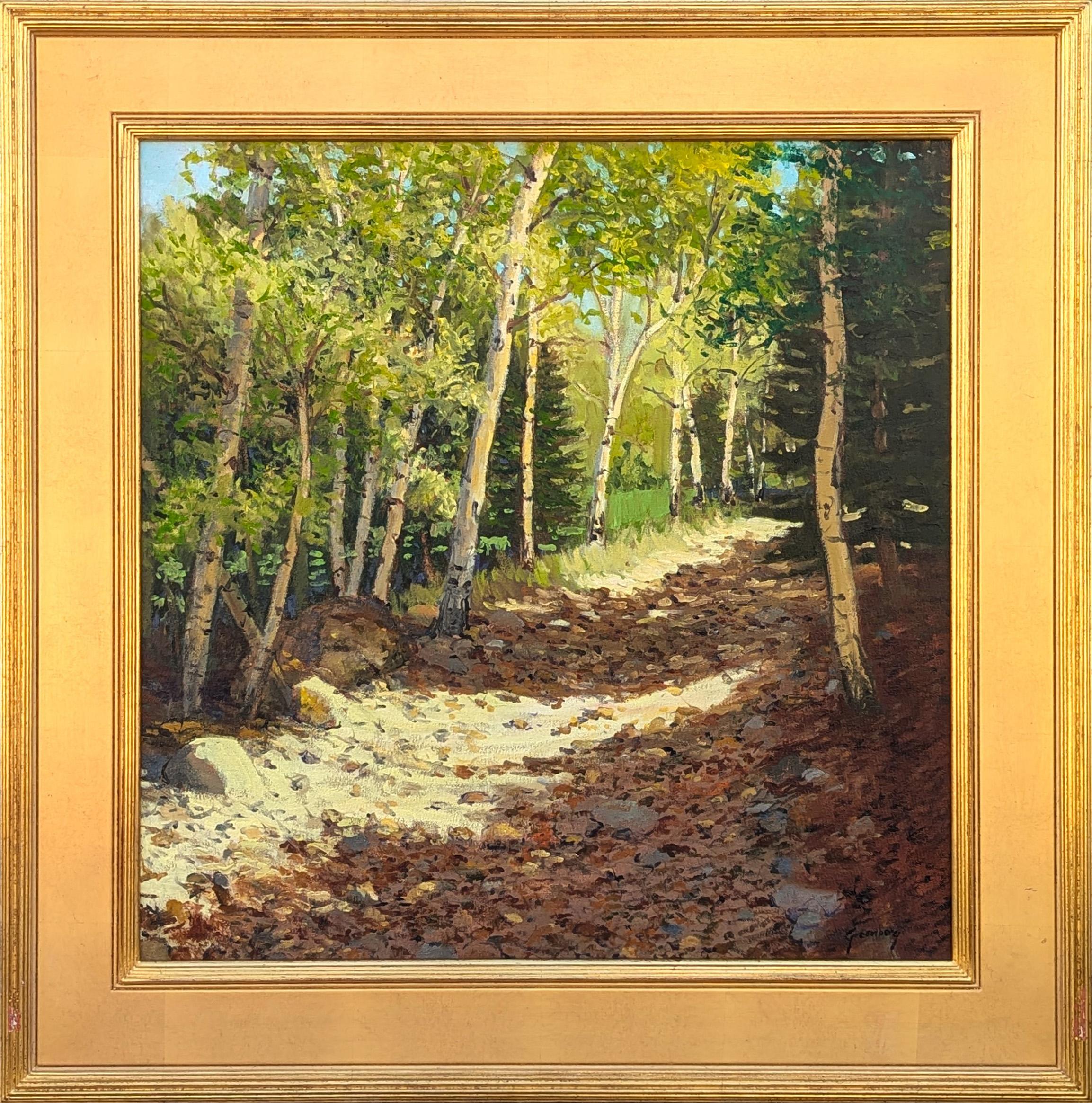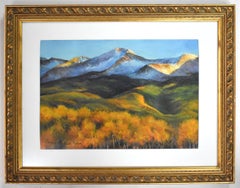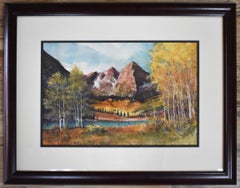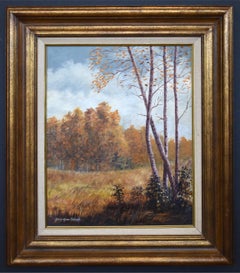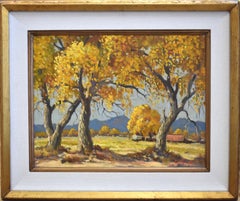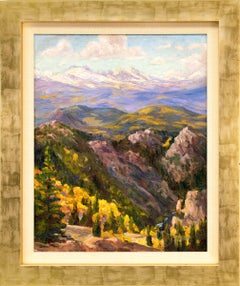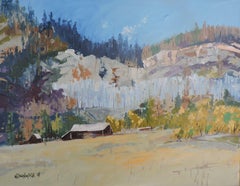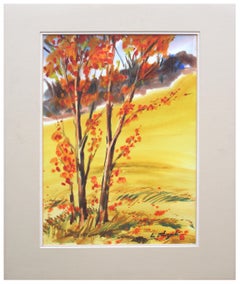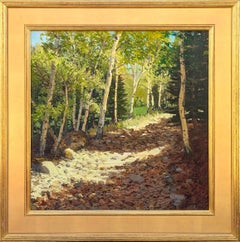Items Similar to "LINGERING COLOR OF FOLIAGE WITH AN EARLY DUSTING OF SNOW" ASPEN COLORADO
Want more images or videos?
Request additional images or videos from the seller
1 of 7
Edward Lee Reichert"LINGERING COLOR OF FOLIAGE WITH AN EARLY DUSTING OF SNOW" ASPEN COLORADO2003
2003
$2,900
£2,199.47
€2,526.17
CA$4,154.65
A$4,573.96
CHF 2,337.76
MX$54,591.50
NOK 29,764.72
SEK 27,853.14
DKK 18,869.04
About the Item
Edward Lee Reichert
(1919-2011)
Texas Artist
Image Size: 19 x 27
Frame Size: 30.5 x 38.5
Medium: Watercolor
Dated 2003
"Lingering Color of Foliage with an Early Dusting of Snow" Aspen CO
Biography
Edward Lee Reichert (1919-2011)
Edward Reichert, architect, designer and artist, is a native Texan who has combined regional, national and international study and practice of the visual art and architecture since 1936. He is a versatile artist and designer, skilled in creating quality landscapes, portraits, architectural, western, religious and varied work in all media. After 36 years of architectural practice based in Houston in which he was involved in the design of more than 400 regional and international projects, he now devotes full time to painting.
Best known of his art works are his designs of stained and faceted art glass which include 100 panels designed for the First United Methodist Church of Houston. In 1983, he wrote and jointly published with the Church, Windows Sharing God’s Caring, an art book with photographs by his wife Elizabeth, illustrating and describing these panels and the historic sanctuary windows.
While attending The University of Texas in Austin he served as art editor of the university publication Architecture, Engineering and Industry (1938-41). After receiving his Bachelor of Architecture Degree and the Alpha Rho Chi Architectural Medal in 1941, he was awarded scholarships for continued studies a M.I.T., Harvard, and Yale. As a Naval Reserve Officer during World II, he authored and illustrated Naval Intelligence publications. He became a Registered Architect in Texas in 1947, AIA member since 1951 and NCARB certified since 1974. He has worked and studied in England, Europe and Canada.
Invitational study and travel with Master Painter, Lajos Markos (1976-1881) in Northern Italy, Mexico and Texas included portraiture, figure drawing, still life and landscape in oils, pastels and conte. In 1983 Reichert studied the “lost wax” process for bronze casting and sculpture at Rice University.
Reichert has had individual showings in Houston, Austin, Beaumont and Central Texas. His drawings and paintings have been exhibited at the University of Texas at Austin; the Coppini Academy of Fine Arts, San Antonio; the Art League of Houston and galleries in South Texas. Commissioned portraits hang in the permanent collection of the University of Texas in Austin, Brown Memorial Library in Rosebud and in corporate offices in Houston.
Honors include the Grumbacher Medal for Best of Show at 1987 CLAG Annual Show. He was initially listed in the Who’s Who in the South and Southwest and the international Who’s Who 1982-83 editions.
- Creator:Edward Lee Reichert (1919 - 2011)
- Creation Year:2003
- Dimensions:Height: 30.5 in (77.47 cm)Width: 38.5 in (97.79 cm)Depth: 3 in (7.62 cm)
- More Editions & Sizes:Image Size: 19 x 27Price: $2,900
- Medium:
- Movement & Style:
- Period:
- Framing:Frame IncludedFraming Options Available
- Condition:Please visit my store front for more mid-century and vintage artwork.
- Gallery Location:San Antonio, TX
- Reference Number:1stDibs: LU769312820882
About the Seller
5.0
Vetted Professional Seller
Every seller passes strict standards for authenticity and reliability
Established in 1974
1stDibs seller since 2017
102 sales on 1stDibs
Typical response time: 1 hour
- ShippingRetrieving quote...Shipping from: San Antonio, TX
- Return Policy
Authenticity Guarantee
In the unlikely event there’s an issue with an item’s authenticity, contact us within 1 year for a full refund. DetailsMoney-Back Guarantee
If your item is not as described, is damaged in transit, or does not arrive, contact us within 7 days for a full refund. Details24-Hour Cancellation
You have a 24-hour grace period in which to reconsider your purchase, with no questions asked.Vetted Professional Sellers
Our world-class sellers must adhere to strict standards for service and quality, maintaining the integrity of our listings.Price-Match Guarantee
If you find that a seller listed the same item for a lower price elsewhere, we’ll match it.Trusted Global Delivery
Our best-in-class carrier network provides specialized shipping options worldwide, including custom delivery.More From This Seller
View All"LAST LIGHT ON BECKWORTH MOUNTAIN" GUNNISON NATIONAL FOREST COLORADO
Located in San Antonio, TX
Edward Lee Reichert
(1919-2011)
Texas Artist
Image Size: 13 x 19
Frame Size: 21..25 x 27.25
Medium: Watercolor
Dated 2004
"Last Light on Beckworth Mountain" Gunnison National Forest Colorado
Biography
Edward Lee Reichert (1919-2011)
Edward Reichert, architect, designer and artist, is a native Texan who has combined regional, national and international study and practice of the visual art and architecture since 1936. He is a versatile artist and designer, skilled in creating quality landscapes, portraits, architectural, western, religious and varied work in all media. After 36 years of architectural practice based in Houston in which he was involved in the design of more than 400 regional and international projects, he now devotes full time to painting.
Best known of his art works are his designs of stained and faceted art glass which include 100 panels designed for the First United Methodist Church of Houston. In 1983, he wrote and jointly published with the Church, Windows Sharing God’s Caring, an art book with photographs by his wife Elizabeth, illustrating and describing these panels and the historic sanctuary windows.
While attending The University of Texas in Austin he served as art editor of the university publication Architecture, Engineering and Industry (1938-41). After receiving his Bachelor of Architecture Degree and the Alpha Rho Chi Architectural Medal in 1941, he was awarded scholarships for continued studies a M.I.T., Harvard, and Yale. As a Naval Reserve Officer during World II, he authored and illustrated Naval Intelligence publications. He became a Registered Architect in Texas in 1947, AIA member since 1951 and NCARB certified since 1974. He has worked and studied in England, Europe and Canada.
Invitational study and travel with Master Painter, Lajos Markos...
Category
21st Century and Contemporary American Impressionist Landscape Drawings ...
Materials
Watercolor
"MAROON BELLS" ASPEN COLORADO MOUNTAINS
Located in San Antonio, TX
Edward Lee Reichert
(1919-2011)
Texas Artist
Image Size: 12 x 18
Frame Size: 21 x 27
Medium: Watercolor
Dated 2005
"Maroon Bells" Aspen CO
Biograph...
Category
Early 2000s American Impressionist Landscape Drawings and Watercolors
Materials
Watercolor
"FALL LANDSCAPE" HILL COUNTRY
By Gary Lynn Roberts
Located in San Antonio, TX
Gary Lynn Roberts
(Born 1953)
Texas Artist
Image Size: 20 x 16
Frame Size: 28.5 x 24.5
Medium: Oil
Dated 1973
"Fall Landscape"
Gary Lynn Roberts (Born 1953)
...
Category
1970s Impressionist Landscape Paintings
Materials
Oil
"Cottonwoods at Peralta" New Mexico Fall Scene
By Leona Turner
Located in San Antonio, TX
Leona Turner
(1929 - 2004)
West Texas / Albuquerque Artist
Image Size: 14 x 18
Frame Size: 21 x 25
Medium: Oil
"Cottonwoods at Peralta"
Biography
Leona Turner (1929 - 2004)
Leona Marie Turner was born and raised in West Texas, where she is well-known and her paintings are sought after. In Albuquerque, she taught classes to most every aspiring artist in New Mexico and many from Arizona, including Curt Walters.
She was proficient with oil paints, watercolor and pastels, and her works hang in numerous important places in the Southwest.
Many portraits were commissioned from Jackson Hole, Wyoming, to Amarillo, Dallas and El Paso, Texas. Internationally known artist Curt Walters commissioned a 40x60 oil portrait in 1990.
Ms. Turner was a member of many art societies, including the National Portrait Society, National Water Color Society, New Mexico Watercolor...
Category
1950s Impressionist Landscape Paintings
Materials
Oil
"WESTERN MOUNTAIN LANDSCAPE" AUSTIN ARTIST FRAMED 27 X 46
By A.D. Greer
Located in San Antonio, TX
A. D. Greer
(1904-1998)
Austin Artist
Image Size: 21 x 40
Frame Size: 27 x 46
Medium: Oil
"Mountains"
Biography
A. D. Greer (1904-1998)
A.D. Greer (Austin Artist)
An artist, poet, le...
Category
1960s Impressionist Landscape Paintings
Materials
Oil
"Texas Hill Country Fall" Fall Colos orange, yellow, etc.
By Harold Roney
Located in San Antonio, TX
Harold Roney Fall colors. Oranges, Yellows, Reds, etc.
(1899 - 1986)
San Antonio, Boerne Artist
Image Size: 26 x 32
Frame Size: 34 x 40
Medium: Oil
Texas Hill Country in Fall
Biogr...
Category
1950s Impressionist Landscape Paintings
You May Also Like
Boulder Canyon, Colorado Autumn Landscape Oil Painting by Irene Fowler, 1940s
By Irene Fowler
Located in Denver, CO
This vintage 1940s oil on canvas painting by Colorado artist Irene Fowler (1884–1969) beautifully captures the vibrant autumn landscape of Boulder Canyon. With a masterful eye for color and atmosphere, Fowler presents majestic mountain peaks framed by glowing Aspen trees in their fall brilliance, their leaves shimmering in radiant shades of gold, orange, and red. The scene reflects both the serenity and dramatic character of Colorado’s rugged wilderness, offering a timeless vision of the Rocky Mountains.
Fowler’s keen observation of light and painterly brushwork bring the landscape vividly to life, evoking the crisp mountain air and golden glow of a Colorado autumn day. Her ability to balance natural grandeur with intimate detail makes this work an exceptional example of early 20th-century Western American painting.
The painting itself measures 22 ¼ x 18 ¼ inches and is presented in a custom gilded frame with outer dimensions of 25 ¼ x 21 ¼ x 1 ½ inches, enhancing its elegance and making it ready for display. Signed by the artist in the lower right corner.
About the Artist:
Irene Fowler (1884–1969) was a pivotal figure in Denver’s early 20th-century art community. Born in Illinois, she later settled in Colorado, where she became both a respected public school teacher and a founding member of the Denver Artists Guild (now the Colorado Artists Guild). Best known for her en plein air landscapes, Fowler captured the beauty of Colorado’s mountains, Aspen groves, and mining towns with an extraordinary sensitivity to light, color, and atmosphere.
She exhibited widely throughout her career, including at the Schlier Gallery, Chappell House, University Club...
Category
1940s American Impressionist Landscape Paintings
Materials
Oil
Colorado Autumn, Painting, Oil on Other
By Richard Szkutnik
Located in Yardley, PA
original en plein air oil on panel paint near Durango, Colorado :: Painting :: Impressionist :: This piece comes with an official certificate of authenticity signed by the artist :: ...
Category
2010s Impressionist Paintings
Materials
Oil
Aspen in Fall, 1970s Vintage Autumn Landscape Watercolor
By Lewis Suzuki
Located in Soquel, CA
A vibrant 1970's vintage autumn watercolor landscape scene of an aspen tree with fall foliage by Lewis Suzuki (American, 1920-2016). Artist's signatu...
Category
1970s American Impressionist Landscape Drawings and Watercolors
Materials
Watercolor, Rag Paper
$700 Sale Price
20% Off
"Mountain Road" Contemporary Realistic Colorado Aspen Tree Landscape Painting
Located in Houston, TX
Contemporary realistic Colorado landscape nature painting by Houston based artist Jerry Greenberg. The work features sunlight streaming onto a rock path lined with aspen trees. Signed in the front lower right corner as well as titled on the reverse. Currently hung in a gold frame.
Dimensions Without Frame: H 24 in. x W 24 in.
Artist Biography: I have a deep appreciation for nature. In my work I seek to convey the landscape as I experience it emotionally as well as visually. I travel frequently throughout the United States and Europe in search of new landscapes. Some of my favorite subjects include rivers and creeks in the Texas hill country; aspen trees in the Rocky Mountains; ponds in New England; and lush rolling hills in the English countryside. My influences include French and Russian Impressionists and early California landscape...
Category
2010s Naturalistic Landscape Paintings
Materials
Oil
Snowy Peak, California Sierra Mountain Landscape
By Kenneth Lucas
Located in Soquel, CA
Striking vertical landscape of a dramatic rocky mountain peak towering above the tree line by Ken Lucas (American, 20th Century). "Ken Lucas" and "#33 March 3, 1993" are written on ...
Category
1990s American Impressionist Landscape Paintings
Materials
Canvas, Oil, Cardboard
$588 Sale Price
20% Off
"October Inspiration" Landscape Painting with Aspens Fall Colors
Located in Austin, TX
A luminous landscape painting of an aspen forest with white tree trunks and vibrant fall foliage in orange and gold. The distant background features a purple, Rocky Mountain vista...
Category
21st Century and Contemporary Post-Impressionist Landscape Paintings
Materials
Canvas, Oil
More Ways To Browse
Painting With Snow
Aspen Colorado Art
Chi Rho
Texas Still Life
Lajos Markos
Paintings Of Aspens
Edward Lee Reichert
Castle Chillon
Charles Culver Paintings
Charles De Wolf Brownell
Crashing Waves Watercolor
Groups Of Women Paintings
Helen Allingham
Henry Charles Fox
Hugh Ferriss
Joseph Southall
Museum Bee
Museum Bees
